Article: IntelŪ PentiumŪ D 805 and IntelŪ PentiumŪ D 820 Duel (Mainstream Dual Core Brethren)
Many thanks to IntelŪ for providing the processor.
IV. Benchmarking

Note that all settings here are on automatic, except for the RAM which is set to run at DDR2-533MHz@CL3-3-3-9. This is needed since the motherboard will automatically use a 667MHz frequency for the RAM, making the RAM run at DDR2-667MHz at just the stock setting of 200MHz FSB.
For benchmark, all results will be acquired from three(3) runs, removing the highest and lowest score, but not averaging the total score of the three. This limit the number of random peaks of scores, and hopes to reduce the number of random unusual results. There will be no online submission of score because of time constraint and software limitation.
::Non-multicore-aware Bench Test::
PCMark02
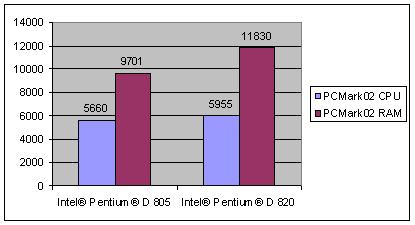
3DMark01SE
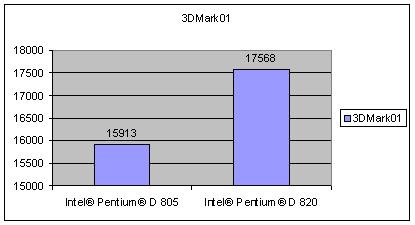
The presudo-single core test suites composed of non multi-threaded optimized benchmarks. PCMark02 and 3DMark01SE
are chosen since they are good for such kind of stress test. These benchmarks were conceived when
dual core for desktop computing isn't a reality.
As the results have shown, the CPU score of the PCMark02 confirmed the ~5.2% difference in CPU speed, with the
faster IntelŪ PentiumŪ D 820 showing a ~5.9% performance boost over the IntelŪ PentiumŪ D 805. The memory results
also shows better bandwidth on the IntelŪ PentiumŪ D 820 with ~21.9% performance increase.
These differences reflect on the gaming test results for the single-threaded application on 3DMark01SE. The
IntelŪ PentiumŪ D 820 boast of 10% performance increase in gaming against the younger brother IntelŪ PentiumŪ D 805.
However, it is important to note that both processors have passed a very high score for 3DMark01 and as such,
performance is hardly noticeable for these two except when benchmarking. I have played a game of Starcraft,
Warcraft III, SimCity 4, and Counter Strike and I felt no lag whatsoever in any of the two.
::Multicore-aware Bench Test::
PCMark04
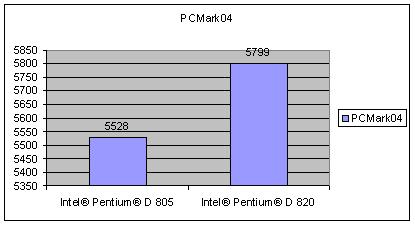
PCMark05
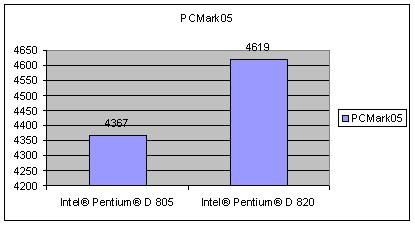
Sandra-CPU
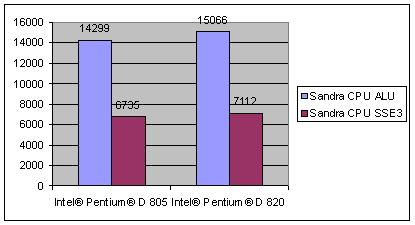
Sandra-Multimedia

Sandra-RAM Bandwidth
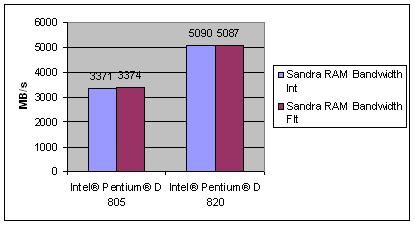
The multicore-aware test suites composed of multi-threaded/multi-core optimized benchmarks.
PCMark04, and PCMark05 are chosen since they are good for such kind of stress test and have
a wide array of test suites to fit a typical multi tasking environment. Both of these software
are industry standard and its results are accepted as non-bias.
It is interesting to note that the ~5.2% difference in clock speed between the two processors
are pretty much measurable and reflective of the score. PCMark04 shows a ~4.9% performance increase
while PCMark05 shows a ~5.7% performance increase by an IntelŪ PentiumŪ D 820 over the IntelŪ PentiumŪ D 805
making the benchmark a good way of measuring the actual performance metric of a system.
These results and performance difference are reinforced when using a different suite of benchmark,
in the incarnation of SiSoft SANDRA. All benchmark results shows the relative ~5.x% increase in CPU
scores across the test and improved performance on the RAM benchmarks.
3DMark03
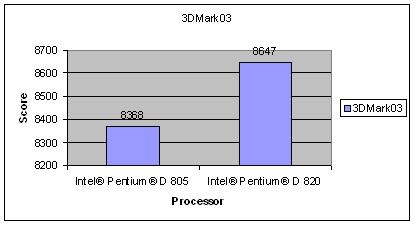
3DMark05
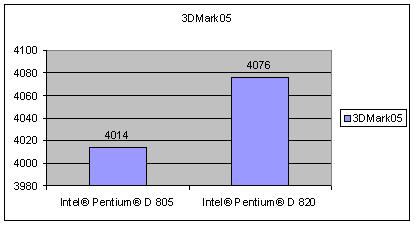
To show how On GPU-bound games are performing, I chose two 3DMark benchmarks: 3DMark03 and 3DMark05.
These two benchmarks are matured already in the market and have been patched a couple of more times already
making them a good and stable way to measure peformance of 3D Games that are mostly driven by GPU than CPU.
As the shown by benchamrk results, the performance increase between the two processors are marginal at best.
Both 3DMark03 and 3DMark05 clearly shows that there is hardly any noticeable difference in gaming between
these processors with an IntelŪ PentiumŪ D 820 getting a decent ~3.3% increase by 3DMark03 and ~1.54% increase
by 3DMark05 over the IntelŪ PentiumŪ D 805.